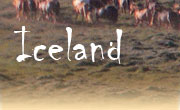
|
Horseback riding tours
Rides in
Iceland
Intro to Iceland
![]() East and South East and South![]() Iceland Shorts Iceland Shorts![]() Northern Tours Northern Tours![]() West West
Also see:
Hiking Trips
Horseback in:
Norway
Finland
Europe Overview
|

|
|

|
|
|

Rift Valley Ride
East and South
Iceland
This tour takes you straight into the Rift Valley in Þingvellir National Park. While riding on secluded lava and birch lined trails in between the North American and Eurasian continental plates you will get a magnificent insight into the fascinating geology and history of Iceland!
Imagine tölting on our soft and gentle horses through lava fields, over highland plateaus and along lovely lake shores as you will discover the wonderful natural wonders of the South. Explore the ancient parliamentary place which is the birthplace of the Icelandic Nation. Your tour also includes visits to Geysir hot spring, the Golden Waterfall Gullfoss and to the geothermal Fontana SPA, where you can sweat in the steam of a natural hot spring and jump into Lake Laugarvatn to cool off!
|
Short Getaway
Family Vacation
Ride with Gaited Horses
Center-based ride
|
|
Meeting:
|
|
|
Airport:
|
Keflavik Airport
|
|
Transfer:
|
|
|
Riders:
|
Min
2 riders
Max
4 riders
|
|
Trip Brochure (PDF)  Trip Rating
Trip Rating

|
|
|
|
Rates and Dates for 2026
Rates include*:
Accommodation with half board (breakfast and lunch), Transfers, 4 Riding days according to program & Visit to Fontana Spa including entrance and towel
| A | 2026 | 4 day trip | 4d / 3n | ISK399900 | $3200 |
�����������������������������������������������������������������������������������������������������������������������������������������������������������������������������������������������������������������������������������������������������������������������������������������������������������������������������������������������������������������������������������������������������������������������������������������������������������������������������������������������������������������������������������������������������������������������������������������������������������������������������������������������������������������������������������������������������������������������������������������������������������������������������������������������������������������������������������������������������������������������������������������������������������������������������������������������������������������������������������������������������������������������������������������������������������������������������������������������������������������������������������������������������������������������������������������������������������������������������������������������������������������������������������������������������������������������������������������������������������������������������������������������������������������������������������������������������������������������������������������������������������������������������������������������������������������������������������������������������������������������������������������������������������������������������������������������������������������������������������������������������������������������������������������������������������������������������������������������������������������������������������������������������������������������������������������������������������������������������������������������������������������������������������������������������������������������������������������������������������������������������������������������������������������������������������������������������������������������������������������������������������������������������������������������������������������������������������������������������������������������������������������������������������������������������������������������������������������������������������������������������������������������������������������������������������������������������������������������������������������������������������������������������������������������������������������������������������������������������������������������������������������������������������������������������������������������������������������������������������������������������������������������������������������������������������������������������������������������������������������������������������������������������������������������������������������������������������������������������������������������������������������������������������������������������������������������������������������������������������������������������������������������������������������������������������������������������������������������������������������������������������������������������������������������������������������������������������������������������������������������������������������������������������������������������������������������������������������������������������������������������������������������������������������������������������������������������������������������������������������������������������������������������������������������������������������������������������������������������������������������������������������������������������������������������������������������������������������������������������������������������������������������������������������������������������������������������������������������������������������������������������������������������������������������������������������������������������������������������������������������������������������������������������������������������������������������������������������������������������������������������������������������������������������������������������������������������������������������������������������������������������������������������������������������������������������������������������������������������������������������������������������������������������������������������������������������������������������������������������������������������������������������������������������������������������������������������������������������������������������������������������������������������������������������������������������������������������������������������������������������������������������������������������������������������������������������������������������������������������������������������������������������������������������������������������������������������������������������������������������������������������������������������������������������������������������������������������������������������������������������������������������������������������������������������������������������������������������������������������������������������������������������������������������������������������������������������������������������������������������������������������������������������������������������������������������������������������������������������������������������������������������������������������������������������������������������������������������������������������������������������������������������������������������������������������������������������������������������������������������������������������������������������������������������������������������������������������������������������������������������������������������������������������������������������������������������������������������������������������������������������������������������������������������������������������������������������������������������������������������������������������������������������������������������������������������������������������������������������������������������������������������������������������������������������������������������������������������������������������������������������������������������������������������������������������������������������������������������������������������������������������������������������������������������������������������������������������������������������������������������������������������������������������������������������������������������������������������������������������������������������������������������������������������������������������������������������������������������������������������������������������������������������������������������������������������������������������������������������������������������������������������������������������������������������������������������������������������������������������������������������������������������������������������������������������������������������������������������������������������������������������������������������������������������������������������������������������������������������������������������������������������������������������������������������������������������������������������������������������������������������������������������������������������������������������������������������������������������������������������������������������������������������������������������������������������������������������������������������������������������������������������������������������������������������������������������������������������������������������������������������������������������������������������������������������������������������������������������������������������������������������������������������������������������������������������������������������������������������������������������������������������������������������������������������������������������������������������������������������������������������������������������������������������������������������������������������������������������������������������������������������������������������������������������������������������������������������������������������������������������������������������������������������������������������������������������������������������������������������������������������������������������������������������������������������������������������������������������������������������������������������������������������������������������������������������������������������������������������������������������������������������������������������������������������������������������������������������������������������������������������������������������������������������������������������������������������������������������������������������������������������������������������������������������������������������������������������������������������������������������������������������������������������������������������������������������������������������������������������������������������������������������������������������������������������������������������������������������������������������������������������������������������������������������������������������������������������������������������������������������������������������������������������������������������������������������������������������������������������������������������������������������������������������������������������������������������������������������������������������������������������������������������������������������������������������������������������������������������������������������������������������������������������������������������������������������������������������������������������������������������������������������������������������������������������������������������������������������������������������������������������������������������������������������������������������������������������������������������������������������������������������������������������������������������������������������������������������������������������������������������������������������������������������������������������������������������������������������������������������������������������������������������������������������������������������������������������������������������������������������������������������������������������������������������������������������������������������������������������������������������������������������������������������������������������������������������������������������������������������������������������������������������������������������������������������������������������������������������������������������������������������������������������������������������������������������������������������������������������������������������������������������������������������������������������������������������������������������������������������������������������������������������������������������������������������������������������������������������������������������������������������������������������������������������������������������������������������������������������������������������������������������������������������������������������������������������������������������������������������������������������������������������������������������������������������������������������������������������������������������������������������������������������������������������������������������������������������������������������������������������������������������������������������������������������������������������������������������������������������������������������������������������������������������������������������������������������������������������������������������������������������������������������������������������������������������������������������������������������������������������������������������������������������������������������������������������������������������������������������������������������������������������������������������������������������������������������������������������������������������������������������������������������������������������������������������������������������������������������������������������������������������������������������������������������������������������������������������������������������������������������������������������������������������������������������������������������������������������������������������������������������������������������������������������������������������������������������������������������������������������������������������������������������������������������������������������������������������������������������������������������������������������������������������������������������������������������������������������������������������������������������������������������������������������������������������������������������������������������������������������������������������������������������������������������������������������������������������������������������������������������������������������������������������������������������������������������������������������������������������������������������������������������������������������������������������������������������������������������������������������������������������������������������������������������������������������������������������������������������������������������������������������������������������������������������������������������������������������������������������������������������������������������������������������������������������������������������������������������������������������������������������������������������������������������������������������������������������������������������������������������������������������������������������������������������������������������������������������������������������������������������������������������������������������������������������������������������������������������������������������������������������������������������������������������������������������������������������������������������������������������������������������������������������������������������������������������������������������������������������������������������������������������������������������������������������������������������������������������������������������������������������������������������������������������������������������������������������������������������������������������������������������������������������������������������������������������������������������������������������������������������������������������������������������������������������������������������������
* prices are per person based on double/twin occupancy
Transfer and Other Charges:
|
2026
|
Transfer from/to downtown Reykjavik is included ats et times
|
ISK
0
|
$0
|
|
2026
|
Single supplement
|
ISK
63,000
|
$505
|
Pick-up / drop-off for this trip is from downtown Reykjavík.
Transfers can be arranged from/to your accommodation in Reykjavík or at the BSÍ bus terminal.
Rates do not include:
Dinners, Travel insurance (mandatory) & Gratuities
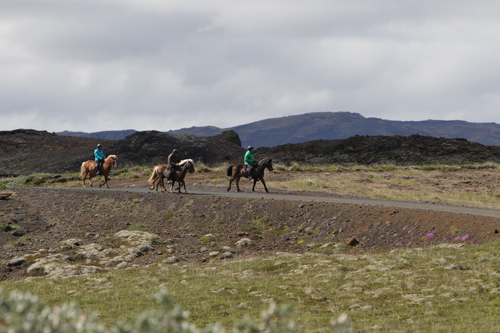 Sample Itinerary
Sample Itinerary - subject to changes
We reserve the right to alter routes, itineraries or timetables should the necessity arise. The estimated duration of tours as indicated by km can change according to road or weather conditions.
Day 1 (Thursday): Riding toward the National Park
Pick up at 10 am at your accommodation in Reykjavík by your wonderful Icelandic hosts! Today´s ride will take you through a stunning mountain landscape with basalt columns, Tröllafoss waterfall and beautiful mountain views. The ride ends at a local farm. We drive the horses to Thingvellir National Park and go by car to your hotel accommodation for next 3 nights.
Riding approx 15 km
Meals included: Lunch
Overnight at Hotel Grímsborgir
Day 2 (Friday): Rift Valley Ride
Today we spend the whole day riding in the beautiful National Park. We begin with riding the new Bláskógaleið where we will be riding with a herd of loose running spare horses to the farm ruins of Gjábakki. Here we will enjoy a hearty lunch. After lunch we will take you on an exciting ride „in between the continents“ as you will be riding in the rift valley between the dividing plates of North America and Eurasia! We then ride into and over one of the many rift zones which will be for sure an adventure to remember! After the ride we will go visiting the famous historical sights of Þingvellir National Park. This place is really the heart of the Icelandic Nation. Here the Icelanders met for their annual Thing meetings from 930 to the end of the 18th century, it is here where they decided to take on Christianity in the year 1000 and declared independence in 1944. We end the day by driving to Fontana Spa for soaking in the geothermal pool and enjoy the oldest sauna in Iceland.
Riding approx 20 km
Meals included: Breakfast & Lunch
Overnight at Hotel Grímsborgir
Day 3 (Saturday): Gullfoss – Geysir – Friðheimar - Riding through Game of Thrones scenery
After breakfast we go on a fascinating sightseeing tour to the famous Golden Circle i.e. we will admire the Golden Waterfall Gullfoss and enjoy the hot spring area of Geysir with spouting Strokkur (the churn). Before heading back to Thingvellir we enjoy lunch and a stable visit at Friðheimar greenhouse restaurant which is absolutely lovely and unique in the world! We enjoy a great ride through the National Park in the afternoon with stunning trails through old farms and famous Games of Thrones scenery.
Riding approx 15 km
Meals included: Breakfast & Lunch
Overnight at Hotel Grímsborgir
Day 4 (Sunday): Riding back towards Reykjavik
Today we will ride back towards Reykjavik. We ride along and over river Öxará (the Ax River) and over heaths and meadows towards the capital area. There are several routes to choose from as riding to/from the National Park was the most popular route during centuries. When we are getting closer to Reykjavik we take you by car to your accommodation in Reykjavík in the late afternoon. (ca. 35 km) Exploring Iceland reserves the right to alter routes, itineraries or timetables should the necessity arise.
Riding approx 35 km
Meals included: Breakfast & Lunch
Non Riders
Non-Riding companions are welcome to join this tour (please inquire for rates). The area offers great opportunities for self-drive tours while your travelling partner is out trail riding.
Airport:
Keflavik Airport
Pick-up / drop-off for this trip is from downtown Reykjavík.
Transfers can be arranged from/to your accommodation in Reykjavík or at the BSÍ bus terminal.
|
Tack:
|
|
Icelandic
|
|
Horses:
|
|
Icelandic Horses
|
|
Pace:
|
|
Riding 15-25 km per day (3-6 hours in the saddle)
|
Walk |
Trot |
Canter |
|
|
Level:
|
|
 (4
out of 5) Strong Intermediate
(4
out of 5) Strong Intermediate
|
|
Age:
|
|
Min
12
|
|
|
Weight:
|
|
Max
210 lbs / 95 kg
|
|
Riders:
|
|
Min
2 riders
|
Max
4 riders
|
|
|
|
|
Riding helmets are mandatory for this ride.
|
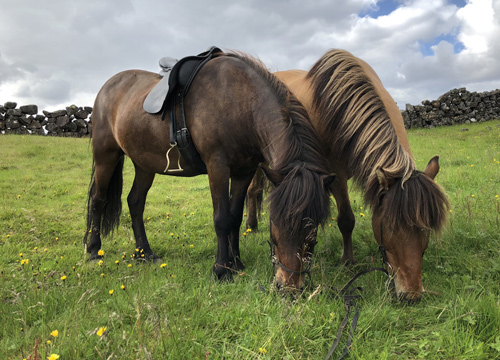
We usually ride with some spare horses as we ride at least 2 horses every day. We mostly ride at a tölt but also walk, trot and canter.
We operate our horse riding tours in Iceland in cooperation with local partners that are horse people through and through.
They breed their own horses and train them themselves. They operate their tours in their home region where they know each and every mountain, creek and canyon.
Riding Gear
Our tack is very similar to the one used by English style riding. But don´t worry if you come from a Western Riding background, we will assist you and you will get used to the tack in no time. We use safety stirrups on all our saddles and will ask you to wear a helmet at all times. You can bring your own helmet (please disinfect your riding gear) or you can borrow one locally.
Our bridles are very practical, they have clip on reins that you can release so that your horse can have some grass while you enjoy your break! We also provide you with a saddle bag, big enough for your picnic, gloves and a small camera.
Riding with the Herd
One of the things that makes riding tours in Iceland completely different from tours in other countries is the fact that we take lots of spare horses along when we travel. The sight of 40 – 80 horses running free over the mountain trails with the wind in their mane is a view you will not forget – we promise! On each tour you can expect to ride different horses every day. That means that we need at least three to four horses per person. The horses we are not riding run along freely in a herd.
Our partners and their staff will take care of the herd and if you want to, you can help them with the herding. But please note that you should always follow the instructions by the staff. We will go over the safety procedures on the first day of the trip. Riding with the herd is a once- in- a -lifetime experience for every rider!
Riding Experience
You do not need any prior knowledge of Icelandic Horses or the special gait tölt. We will explain our way of riding and will take time and patience to teach you how to ride the tölt. However, you might get more out of a multi-day trip if you know already a little bit about tölting. This is why we offer a pre-tour for our multi-day tours in cooperation with our partners (inquire for more information). We especially recommend this pre-tour for riders that are used to Western Riding. But as already mentioned above, this pre-tour is just a service to make sure you enjoy the tour even more but it is not a requirement. We will take good care of you either way!
Horse Welfare
Horse Welfare is not just a slogan for us. All of our Team Members own horses and ride on a regular basis. Some of us even breed horses. We love horses - in fact they are everything to us! That is why we carefully pick and choose our partners. We visit them on a regular basis – even without prior notice - to make sure that their horses are kept in good conditions all year round. That is also the reason why you will not find many departures in a row for our tours.
We want to make sure that both horses and the human team behind each tour gets a good rest in between departures so that they can deliver 100% service once you arrive.
During a typical year our horses are kept outside 24/7 during summer on usually rather large fields with access to good grazing and fresh water. If they are close to the stable or a paddock we will keep them there for a few hours during the day when we want to ride them in order to have them nearby and dry. Also in some cases to prevent them from eating 24 hours! Obesity can be a problem in Icelandic Horses. During autumn (usually from Mid September to December) we take their shoes off (all horses in Iceland are ridden with shoes) and they are turned onto big autumn fields where they live nearly „half-wild“ in large herds. During this time they are completely „on vacation“, they are not ridden but we visit them regularly to make sure that every horse is doing well. End of December/beginning of January we take the young and competition horses into the stable for training. Then they are kept in stalls but the Icelandic Law for Horse Welfare states clear regulations regarding stall sizes, daily playtime outside, paddock fencing, food... Older fully trained horses, breeding mares, untrained youngster and horses that are not ridden during wintertime like many of our horses that we use for the tours usually stay outside on winter fields in large herds where they are fed with hay and where sufficient water and wind protection is provided, either natural or man made. From May/June all horses again are on summer fields where they stay outside 24/7 feeding on grass. A few exemptions from these rules are made regarding stallions due to their nature.
Travel Insurance
Individual travel insurance is not included in the tour prices. We urge our guests to purchase relevant travel insurance before visiting Iceland. Guests from Europe should bring their European Health Insurance Card (EHIC).
Passport and Visa Requirements:
Passport valid for at least three months beyond length of stay required by all except:(a) 1. nationals of Austria, Belgium, Denmark, Finland, France, Germany, Greece, Italy, Luxembourg, the Netherland. more
Reykjavík area
|
Month
|
Jan
|
Feb
|
Mar
|
Apr
|
May
|
Jun
|
Jul
|
Aug
|
Sep
|
Oct
|
Nov
|
Dec
|
|
Average High Temperature (°F)
|
37
|
37
|
39
|
43
|
49
|
54
|
57
|
57
|
51
|
45
|
40
|
37
|
|
Average Low Temperature (°F)
|
27
|
28
|
29
|
33
|
39
|
44
|
48
|
47
|
42
|
36
|
31
|
28
|
|
Average High Temperature (°C)
|
3
|
3
|
4
|
6
|
10
|
12
|
14
|
14
|
11
|
7
|
4
|
3
|
|
Average Low Temperature (°C)
|
-3
|
-2
|
-2
|
1
|
4
|
7
|
9
|
8
|
6
|
2
|
-1
|
-2
|
|
Average Precipitation (days of rain)
|
13
|
13
|
14
|
11
|
10
|
9
|
9
|
12
|
12
|
12
|
12
|
14
|
Source: NOAA
Seasons
Iceland in the path of the North Atlantic Current (aka Gulf Stream), which makes its climate more temperate than one would expect for its latitude just south of the Arctic Circle.
The weather in Iceland is notoriously variable and often very windy. On our highland tours you can expect any kind of weather and good preparation is a key to a successful journey. When the sun is shining you need to apply strong sun protection similar to the one you would use while skiing in the Alps for example.
Good layers of thermal underwear and ideally woolen sweaters in combination with a windproof jacket will keep you warm and snug even in colder temperatures. Good gloves and socks are important as well. A warm rider is a happy rider!
Winter
The average January temperature is 31°F (-0.5°C). From mid-November until the end of January, in the darkness of winter, the country only experiences a few hours of daylight each day.
Summer
The summer temperatures in Reykjavík range from 41°F (5°C) at night to as high as 77°F (25°C) during the day. During the summer months there is almost continuous daylight; early spring and late autumn feature long twilights.
The Northern Lights are often visible in autumn and early winter.
Here are our recommendations on what to bring:
- 2 pairs of good quality riding trousers. We do not recommend to ride in Jeans even if you are used to do so at home.
- 2-3 pullovers – ideally woolen but fleece is ok as well. It is best to have one or two thinner ones and one pullover that you can wear in layers (onion layer method).
- Plenty of woolen socks and gloves. Please note that riding gloves must be new.
- Good high quality thermal underwear (we recommend none-itching Merino wool)
- A good and windproof – ideally waterproof jacket. We do provide you with heavy duty raingear (jackets and trousers) for days with heavy rain but you might want to bring your own lighter jacket for days with wind and drizzle.
- A thin balaclava or buff to wear underneath the helmet
- Moskito net for the head.
- Bathing suits
We offer the possibility of renting a safety vest during the tour (please, let us know if you are interested).
Please make sure that you follow the rules set by the Icelandic Veterinary Authority!
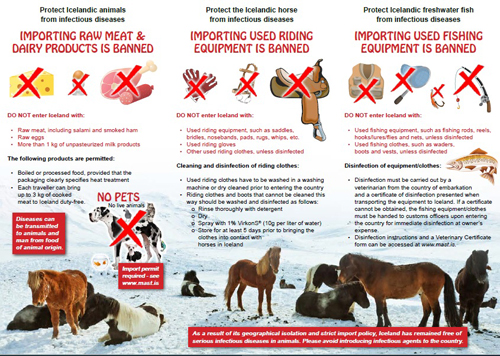
Sorry, no video is currently available for this tour.
*Important Notice: The following ratings have been submitted by guests and do not necessarily represent the views of Hidden Trails, its partners or employees.
Every care is taken to ensure accuracy but Hidden Trails is not liable for any errors or omissions.
** No trip reports found
with the tour ID you provided.
|
..view other reports for different trips
���������������������������������������������������������������������������������������������������������������������������������������������������������������������������������������������������������������������������������������������������������������������������������������������������������������������������������������������������������������������������������������������������������������������������������������������������������������������������������������������������������������������������������������������������������������������������������������������������������������������������������������������������������������������������������������������������������������������������������������������������������������������������������������������������������������������������������������������������������������������������������������������������������������������������������������������������������������������������������������������������������������������������������������������������������������������������������������������������������������������������������������������������������������������������������������������������������������������������������������������������������������������������������������������������������������������������������������������������������������������������������������������������������������������������������������������������������������������������������������������������������������������������������������������������������������������������������������������������������������������������������������������������������������������������������������������������������������������������������������������������������������������������������������������������������������������������������������������������������������������������������������������������������������������������������������������������������������������������������������������������������������������������������������������������������������������������������������������������������������������������������������������������������������������������������������������������������������������������������������������������������������������������������������������������������������������������������������������������������������������������������������������������������������������������������������������������������������������������������������������������������������������������������������������������������������������������������������������������������������������������������������������������������������������������������������������������������������������������������������������������������������������������������������������������������������������������������������������������������������������������������������������������������������������������������������������������������������������������������������������������������������������������������������������������������������������������������������������������������������������������������������������������������������������������������������������������������������������������������������������������������������������������������������������������������������������������������������������������������������������������������������������������������������������������������������������������������������������������������������������������������������������������������������������������������������������������������������������������������������������������������������������������������������������������������������������������������������������������������������������������������������������������������������������������������������������������������������������������������������������������������������������������������������������������������������������������������������������������������������������������������������������������������������������������������������������������������������������������������������������������������������������������������������������������������������������������������������������������������������������������������������������������������������������������������������������������������������������������������������������������������������������������������������������������������������������������������������������������������������������������������������������������������������������������������������������������������������������������������������������������������������������������������������������������������������������������������������������������������������������������������������������������������������������������������������������������������������������������������������������������������������������������������������������������������������������������������������������������������������������������������������������������������������������������������������������������������������������������������������������������������������������������������������������������������������������������������������������������������������������������������������������������������������������������������������������������������������������������������������������������������������������������������������������������������������������������������������������������������������������������������������������������������������������������������������������������������������������������������������������������������������������������������������������������������������������������������������������������������������������������������������������������������������������������������������������������������������������������������������������������������������������������������������������������������������������������������������������������������������������������������������������������������������������������������������������������������������������������������������������������������������������������������������������������������������������������������������������������������������������������������������������������������������������������������������������������������������������������������������������������������������������������������������������������������������������������������������������������������������������������������������������������������������������������������������������������������������������������������������������������������������������������������������������������������������������������������������������������������������������������������������������������������������������������������������������������������������������������������������������������������������������������������������������������������������������������������������������������������������������������������������������������������������������������������������������������������������������������������������������������������������������������������������������������������������������������������������������������������������������������������������������������������������������������������������������������������������������������������������������������������������������������������������������������������������������������������������������������������������������������������������������������������������������������������������������������������������������������������������������������������������������������������������������������������������������������������������������������������������������������������������������������������������������������������������������������������������������������������������������������������������������������������������������������������������������������������������������������������������������������������������������������������������������������������������������������������������������������������������������������������������������������������������������������������������������������������������������������������������������������������������������������������������������������������������������������������������������������������������������������������������������������������������������������������������������������������������������������������������������������������������������������������������������������������������������������������������������������������������������������������������������������������������������������������������������������������������������������������������������������������������������������������������������������������������������������������������������������������������������������������������������������������������������������������������������������������������������������������������������������������������������������������������������������������������������������������������������������������������������������������������������������������������������������������������������������������������������������������������������������������������������������������������������������������������������������������������������������������������������������������������������������������������������������������������������������������������������������������������������������������������������������������������������������������������������������������������������������������������������������������������������������������������������������������������������������������������������������������������������������������������������������������������������������������������������������������������������������������������������������������������������������������������������������������������������������������������������������������������������������������������������������������������������������������������������������������������������������������������������������������������������������������������������������������������������������������������������������������������������������������������������������������������������������������������������������������������������������������������������������������������������������������������������������������������������������������������������������������������������������������������������������������������������������������������������������������������������������������������������������������������������������������������������������������������������������������������������������������������������������������������������������������������������������������������������������������������������������������������������������������������������������������������������������������������������������������������������������������������������������������������������������������������������������������������������������������������������������������������������������������������������������������������������������������������������������������������������������������������������������������������������������������������������������������������������������������������������������������������������������������������������������������������������������������������������������������������������������������������������������������������������������������������������������������������������������������������������������������������������������������������������������������������������������������������������������������������������������������������������������������������������������������������������������������������������������������������������������������������������������������������������������������������������������������������������������������������������������������������������������������������������������������������������������������������������������������������������������������������������������������������������������������������������������������������������������������������������������������������������������������������������������������������������������������������������������������������������������������������������������������������������������������������������������������������������������������������������������������������������������������������������������������������������������������������������������������������������������������������������������������������������������������������������������������������������������������������������������������������������������������������������������������������������������������������������������������������������������������������������������������������������������������������������������������������������������������������������������������������������������������������������������������������������������������������������������������������������������������������������������������������������������������������������������������������������������������������������������������������������������������������������������������������������������������������
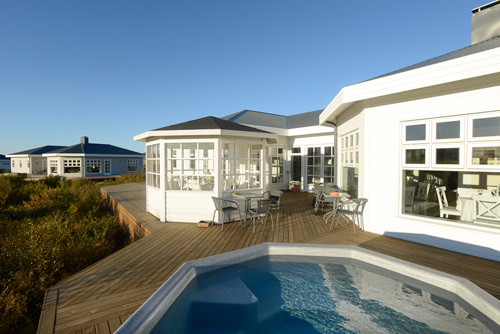 Accommodations
Accommodations
This is a stationary ride so all nights will be spent at the same accommodation.
Description
You will stay at Hotel Grímsborgir. Each of the 68 beautiful and spacious bedroom has a nice terrace, free Wi-Fi access, a TV, a safe as well as a private bathroom with bathtub/shower and hairdryer.
Guests have access to hot tubs in a common area.
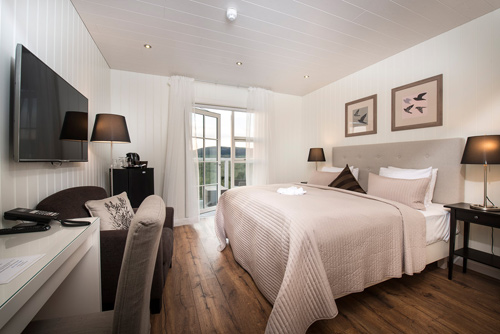
Note that your guide will not be staying at the hotel during the tour.
Room Occupancy
Triple rooms might be available on request (please inquire).
The single supplement fee is mandatory for single travelers.
Meals
During the ride half board is provided with breakfast and lunch.
Dinner is not included on this tour.
The hotel serves a beautiful breakfast buffet featuring a selection of freshly baked breads and pastries, cheeses, cold cuts, vegetables, jams as well as yogurts and muslis, lots of fresh fruits and hot items such as breakfast sausages, bacon and scrambled eggs. The breakfast buffet is open from 07:00 to 10:00 am every day.
Lunch is usually eaten on the trail and features a variety of dishes including: sandwiches, hot dogs, lobster soup, lamb BBQ...
We also provide coffee and cakes at the end of the day, usually home baked or assorted Icelandic cheese etc.
Dietary Restrictions
It is possible to cater to special diets with advance notice.
This trip
can accommodate special dietary requests.
|
Tack:
|
|
Icelandic
|
|
Horses:
|
|
Icelandic Horses
|
|
Pace:
|
|
Riding 15-25 km per day (3-6 hours in the saddle)
|
Walk |
Trot |
Canter |
|
|
Level:
|
|
 (4
out of 5) Strong Intermediate
(4
out of 5) Strong Intermediate
|
|
Age:
|
|
Min
12
|
|
|
Weight:
|
|
Max
210 lbs / 95 kg
|
|
Riders:
|
|
Min
2 riders
|
Max
4 riders
|
|

We usually ride with some spare horses as we ride at least 2 horses every day. We mostly ride at a tölt but also walk, trot and canter.
We operate our horse riding tours in Iceland in cooperation with local partners that are horse people through and through.
They breed their own horses and train them themselves. They operate their tours in their home region where they know each and every mountain, creek and canyon.
Riding Gear
Our tack is very similar to the one used by English style riding. But don´t worry if you come from a Western Riding background, we will assist you and you will get used to the tack in no time. We use safety stirrups on all our saddles and will ask you to wear a helmet at all times. You can bring your own helmet (please disinfect your riding gear) or you can borrow one locally.
Our bridles are very practical, they have clip on reins that you can release so that your horse can have some grass while you enjoy your break! We also provide you with a saddle bag, big enough for your picnic, gloves and a small camera.
Riding with the Herd
One of the things that makes riding tours in Iceland completely different from tours in other countries is the fact that we take lots of spare horses along when we travel. The sight of 40 – 80 horses running free over the mountain trails with the wind in their mane is a view you will not forget – we promise! On each tour you can expect to ride different horses every day. That means that we need at least three to four horses per person. The horses we are not riding run along freely in a herd.
Our partners and their staff will take care of the herd and if you want to, you can help them with the herding. But please note that you should always follow the instructions by the staff. We will go over the safety procedures on the first day of the trip. Riding with the herd is a once- in- a -lifetime experience for every rider!
Riding Experience
You do not need any prior knowledge of Icelandic Horses or the special gait tölt. We will explain our way of riding and will take time and patience to teach you how to ride the tölt. However, you might get more out of a multi-day trip if you know already a little bit about tölting. This is why we offer a pre-tour for our multi-day tours in cooperation with our partners (inquire for more information). We especially recommend this pre-tour for riders that are used to Western Riding. But as already mentioned above, this pre-tour is just a service to make sure you enjoy the tour even more but it is not a requirement. We will take good care of you either way!
Horse Welfare
Horse Welfare is not just a slogan for us. All of our Team Members own horses and ride on a regular basis. Some of us even breed horses. We love horses - in fact they are everything to us! That is why we carefully pick and choose our partners. We visit them on a regular basis – even without prior notice - to make sure that their horses are kept in good conditions all year round. That is also the reason why you will not find many departures in a row for our tours.
We want to make sure that both horses and the human team behind each tour gets a good rest in between departures so that they can deliver 100% service once you arrive.
During a typical year our horses are kept outside 24/7 during summer on usually rather large fields with access to good grazing and fresh water. If they are close to the stable or a paddock we will keep them there for a few hours during the day when we want to ride them in order to have them nearby and dry. Also in some cases to prevent them from eating 24 hours! Obesity can be a problem in Icelandic Horses. During autumn (usually from Mid September to December) we take their shoes off (all horses in Iceland are ridden with shoes) and they are turned onto big autumn fields where they live nearly „half-wild“ in large herds. During this time they are completely „on vacation“, they are not ridden but we visit them regularly to make sure that every horse is doing well. End of December/beginning of January we take the young and competition horses into the stable for training. Then they are kept in stalls but the Icelandic Law for Horse Welfare states clear regulations regarding stall sizes, daily playtime outside, paddock fencing, food... Older fully trained horses, breeding mares, untrained youngster and horses that are not ridden during wintertime like many of our horses that we use for the tours usually stay outside on winter fields in large herds where they are fed with hay and where sufficient water and wind protection is provided, either natural or man made. From May/June all horses again are on summer fields where they stay outside 24/7 feeding on grass. A few exemptions from these rules are made regarding stallions due to their nature.
Travel Insurance
Individual travel insurance is not included in the tour prices. We urge our guests to purchase relevant travel insurance before visiting Iceland. Guests from Europe should bring their European Health Insurance Card (EHIC).
Passports
Passport valid for at least three months beyond length of stay required by all except:
(a) 1. nationals of Austria, Belgium, Denmark, Finland, France, Germany, Greece, Italy, Luxembourg, the Netherlands, Portugal, Spain and Sweden who are only required to produce national identity cards issued by the competent authorities in their countries of origin.
Passport Note
Iceland is a signatory to the 1995 Schengen Agreement.
Visas
Not required by all nationals of referred to in the chart above for stays of up to 90 days.
2. EU nationals staying longer than 90 days will need to apply for a residence permit from the directorate of immigration in Iceland.
Note: Nationals not referred to in the chart above are advised to contact the embassy to check visa requirements (see Contact Addresses).
Visa Note
A stay in another Schengen-Zone country counts as the same as a stay in Iceland.
| Passport Required? |
| British |
Yes |
| Australian |
Yes |
| Canadian |
Yes |
| USA |
Yes |
| Other EU |
Yes/1 |
| Visa Required? |
| British |
No |
| Australian |
No |
| Canadian |
No |
| USA |
No |
| Other EU |
No |
| Return Ticket Required? |
| British |
No |
| Australian |
Yes |
| Canadian |
Yes |
| USA |
Yes |
| Other EU |
No |
This information is not being updated on a regular basis. Hidden Trails does not
take any responsibility for the accuracy of the above information. Please, consult
the embassy or consulate for updated info.
|

|
|
|
Rift Valley Ride
Tour Code:
IT-ICEIL3
4 days /
3 nights
Dates :
September
Difficulty :

Riding Level Explained | A | Beginner
 | Beginner A rider who has limited experience, is unable to post the trot and does not canter. | | B | Novice
 | Novice A rider who is capable of mounting and dismounting unassisted, capable of
applying basic aids, comfortable and in control at the walk, moderate length posting
trots, and short canters. | | C | Intermediate
 | Intermediate A rider who has a firm seat, is confident and in control at all paces
(including posting trots, two point canters and gallops), but does not ride regularly. |
| D | Strong Intermediate
 | Strong Intermediate An intermediate rider who is currently riding regularly and is comfortable in the saddle for at least 6 hours per day. | | E | Advanced
 | All of the above, plus an independent seat, soft hands, and capable of handlinga spirited horse in open country. |

|